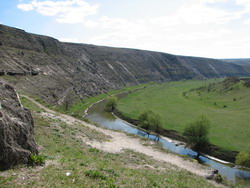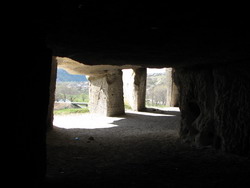
 |
Moldova menuPartners Subscribe for news |
Archaeological complexMoldova Info → Attractions → Old Orhei The archaeological complex Old Orhei is an open-air museum situated between the villages Trebujeni and Butuceni 60 km North East from Chisinau. This territory was peopled from the early times. At this place were established many cities. The first city established here was called Orhei. The name Orhei means “fortification”. Then at the beginning of XIV century the Golden Horde conquered this territory. The oriental city called Shehr al-Cedid was built here. Shehr al-Cedid is translated as “New City”. At the middle of XIV century this town disappears. A new town Orhei appears at this place. At the middle of XVI century Orhei inhabitants moved 18 km to the North. Later there's established a new city with the name Orhei. The name of archaeological reservation derives from the name of that medieval city Orhei which became referred to as «Old Orhei». 
The museum complex Old Orhei is a system of historical monuments and natural landscapes. If consists of few promontories. The central promontory in Old Orhei is called Pestere. Its name derives from the many caves carved in it ('Pestere' is translated from Romanian as 'caves'). The Butuceni headland contributes to the Old Orhei very well. Together with the Pestere promontory it forms complete complex harmonizing from all points of view. The Butuceni promontory is great from both geological view and the view point of unique scenery. It has tens of calcareous slates, spacious caves, small grottos. The wonderful view and ancient traces impress every guest of this place. 
Old Orhei is famous for the cave monasteries located there. This zone was ideal for the primary monasticism of early Christian community. It was isolated from the outer world. At the time when Christians came here there should have been smaller and bigger caves in the calcareous rocks cut by pre-historic tribes living on this territory. The Christians probably used existing caves and penetrated “inside the rocks” in order to “become a rock”. Christian life in the Old Orhei caves became eternal and saint. In the medieval period monastery life intensification made monks to deepen the caves. There also appeared new caves. Nowadays some caves are preserved well. Others were damaged, mainly by earthquakes which are frequent in this area. The researches show that tens of monasteries fell into waters of Raut River. However still many complexes are in good condition. At the Old Orhei there are several monumental stone constructions which attract attention of both scientists and common people. The oldest fortified construction at the Old Orhei is the Gaetic fortress. It is situated on the Butuceni promontory. Its territory has oval prolonged form oriented from East to West. The fortress is connected to the surrounding area by narrow passage. It's easy to block if something happens. So, the place was ideal for building a fortress. The fortress was left at the end of III century BC. The reason was invasions of Germanic and Bastarnae tribes. Another construction of great interest is Medieval Fortress. It appeared when the Golden Horde conquered this territory. The city existing here was turned into oriental one with the name Shehr al-Cedid. The wooden fortress was destroyed and the new stone fortress appeared on its place. Here was built a great building. It had 2 different-sized rooms and underground tomb. The building was also provided by patio. After the city was liberated from the occupation by Golden Horde this building become the residence of the magistrate of Orhei district. From those times patio got aspect of local Moldovan houses. The tomb was turned into cellar which also got aspect of local houses. This building had burned. Probably it happened in 1510 when Tatars fired the whole city. 
In the city built here by Golden Horde 3 feredeus (bathing rooms) were built in different parts of the city. These were public places used for bathing. They were made in oriental style. Foundations of one of these feredeus are preserved till nowadays. The building was of rectangular form. The bath had 2 sections, for men and for women. There was also a special room for resting with stone table and chairs in it. The whole building had central heating. The warm air circulated in the empty spaces under the stone floor and the floor warmed up. In the city established by Golden Horde was also built Khan. It had rectangular form. The khan was provided with a court and had a small building with two gates: the one was for entrance and the other one for leaving. Rooms for clients and for horses were arranged along the interior walls. Khan of this type is preserved till nowadays in Bucharest. To the South East from the Khan there are discovered foundations of a church which had sanctuary, nave and pro-nave of 18 meters long. This church is peculiar. It has widened pro-nave which is separated from the nave by stone wall. It also had four corners on the western wall that also makes it to be peculiar.
|
Weather in Moldova
Many people in the world have never heard about Moldova. They even wonder that such country exists.
Then follow timid wild guesses of its location: Africa! Asia! No? Where it may be? However that happens
through no fault of those people. There’s too few information about Moldova in the Internet. So, the time
to tell the world about Moldova came!
Moldova is a small country which is situated in the Eastern Europe on 47 N, 29 E. |